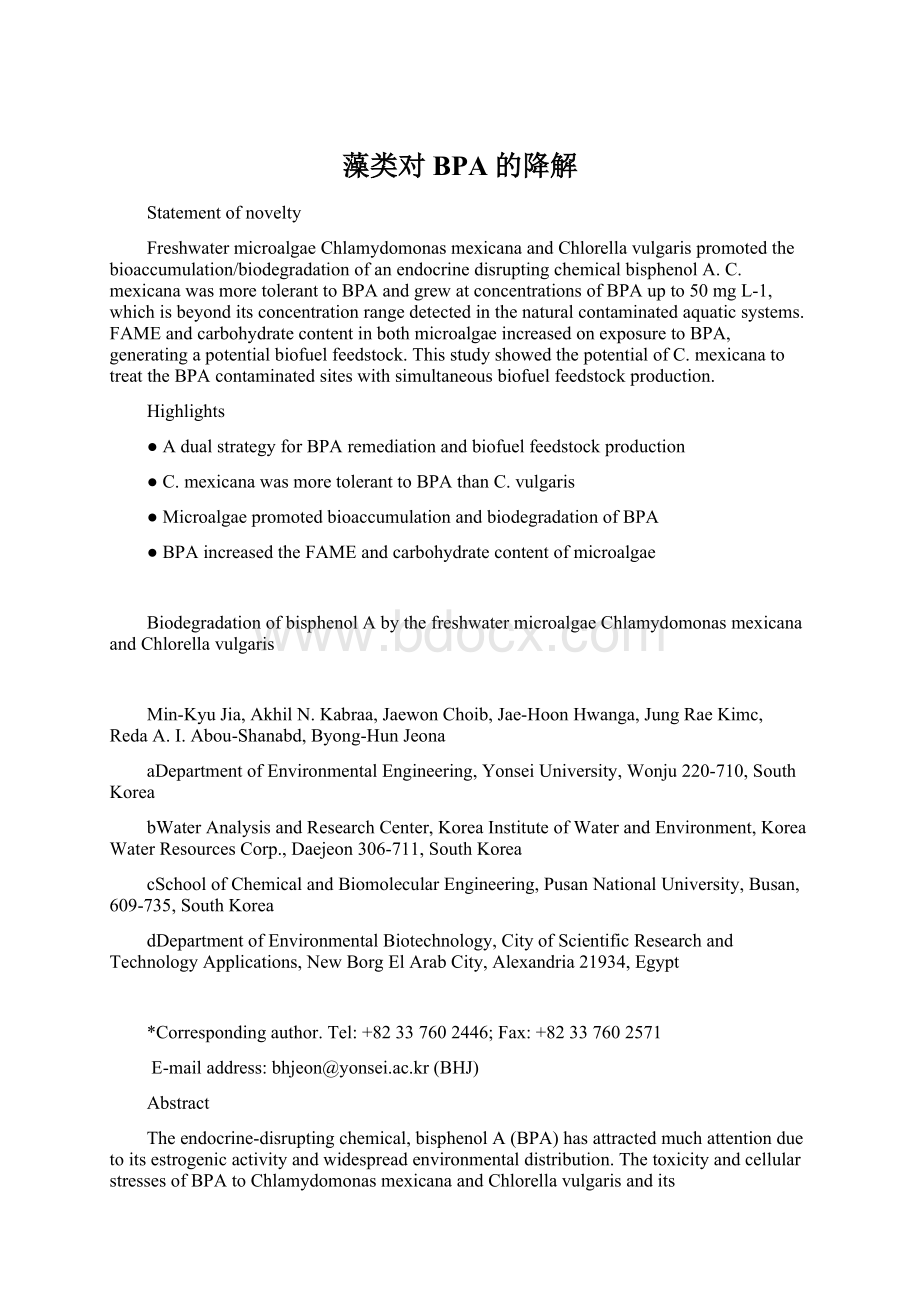藻类对BPA的降解.docx
《藻类对BPA的降解.docx》由会员分享,可在线阅读,更多相关《藻类对BPA的降解.docx(24页珍藏版)》请在冰豆网上搜索。

藻类对BPA的降解
Statementofnovelty
FreshwatermicroalgaeChlamydomonasmexicanaandChlorellavulgarispromotedthebioaccumulation/biodegradationofanendocrinedisruptingchemicalbisphenolA.C.mexicanawasmoretoleranttoBPAandgrewatconcentrationsofBPAupto50mgL-1,whichisbeyonditsconcentrationrangedetectedinthenaturalcontaminatedaquaticsystems.FAMEandcarbohydratecontentinbothmicroalgaeincreasedonexposuretoBPA,generatingapotentialbiofuelfeedstock.ThisstudyshowedthepotentialofC.mexicanatotreattheBPAcontaminatedsiteswithsimultaneousbiofuelfeedstockproduction.
Highlights
●AdualstrategyforBPAremediationandbiofuelfeedstockproduction
●C.mexicanawasmoretoleranttoBPAthanC.vulgaris
●MicroalgaepromotedbioaccumulationandbiodegradationofBPA
●BPAincreasedtheFAMEandcarbohydratecontentofmicroalgae
BiodegradationofbisphenolAbythefreshwatermicroalgaeChlamydomonasmexicanaandChlorellavulgaris
Min-KyuJia,AkhilN.Kabraa,JaewonChoib,Jae-HoonHwanga,JungRaeKimc,RedaA.I.Abou-Shanabd,Byong-HunJeona
aDepartmentofEnvironmentalEngineering,YonseiUniversity,Wonju220-710,SouthKorea
bWaterAnalysisandResearchCenter,KoreaInstituteofWaterandEnvironment,KoreaWaterResourcesCorp., Daejeon306-711,SouthKorea
cSchoolofChemicalandBiomolecularEngineering,PusanNationalUniversity,Busan,609-735,SouthKorea
dDepartmentofEnvironmentalBiotechnology,CityofScientificResearchandTechnologyApplications,NewBorgElArabCity,Alexandria21934,Egypt
*Correspondingauthor.Tel:
+82337602446;Fax:
+82337602571
E-mailaddress:
bhjeon@yonsei.ac.kr(BHJ)
Abstract
Theendocrine-disruptingchemical,bisphenolA(BPA)hasattractedmuchattentionduetoitsestrogenicactivityandwidespreadenvironmentaldistribution.ThetoxicityandcellularstressesofBPAtoChlamydomonasmexicanaandChlorellavulgarisanditsbiodegradation/bioaccumulationbybothmicroalgaewereinvestigated.The120-hEC50ofBPAforC.mexicanaandC.vulgariswere44.8and39.8mgL-1,respectively.ThedrycellweightandchlorophyllacontentofbothmicroalgaedecreasedwithincreasingBPAconcentrationhigherthan10mgL-1.GrowthofC.vulgariswassignificantlyinhibitedat50mgL-1BPAcomparedtoC.mexicana.Totalnitrogen(TN)andtotalphosphorous(TP)removalwashigherinC.mexicanathaninC.vulgaris.MicroalgaeperformedthebioaccumulationandbiodegradationofBPAtovaryingextentsatdifferentinitialBPAconcentrations.ThehighestratesofBPAbiodegradation,24and23%byC.mexicanaandC.vulgaris,respectively,wereachievedat1mgL-1BPA.BoththetotalfattyacidandcarbohydratecontentsincreasedwithincreasingBPAconcentration.ThisstudydemonstratedthatC.mexicanawasmoretoleranttoBPAandcouldbeusedfortreatmentofBPAcontaminatedaqueoussystems.
Keywords:
BisphenolA,Biodegradation,Microalgae,Carbohydrates,Fattyacids
1.Introduction
Populationgrowthandurbanizationtogetherwithparallelglobalindustrializationhaveresultedinsignificantcontaminationofwaterstreamswithawidevarietyofendocrine-disruptingchemicals(EDCs)[1].BisphenolA (BPA),whichisemployedfortheproductionofepoxyresinsandpolycarbonate(PC)plastics,isutilizedinvariousfoodanddrinkpackaging,babybottlesanddentalsealants[2].BPAisastrongendocrinedisruptorandalsoleadstocarcinogenesis[3].Despiteitshazardouseffects,BPAhasbeenextensivelyused,increasingitsglobalconsumptionatanannualrateof5.5%during2009-2012[4].IthasbeenreportedthathumansareprimarilyexposedtoBPAbyingestion,inhalationandskincontactontheorderofmicrogramsperkilogramofbodyweightdaily[5].BPAreleasedfrommanufacturingsitesoritsresiduesfromurbanandindustrialwastewaterseverelycontaminatetheenvironment,primarilyitsaquaticsystems.BPAhasbeendetectedatconcentrationsofapproximately150μgL−1inindustrialwastewaters[6],21μgL−1inrivers[7]and17,200μgL−1inlandfillleachates[8].BPAimposesdeleteriouseffectsonaquaticorganisms,evenatconcentrationsoflessthan1μgL−1[9],makingitsdetectionandremovaltonon-toxiclevelaprimaryconcerninwaterqualitymanagement.
Methodstoremoveenvironmentalpollutants,especiallyBPAincludephoto-degradation[10],oxidation[11],photoelectrocatalyticoxidation[12]andbiodegradation[13].Phytoremediationisasolarpower-driven,ecologicallysoundandsustainablereclamationstrategythatusesplantsforcleaningcontaminatedsites[14].Inrecentyears,phytoremediationofcontaminatedwatersbyphotoautotrophicaquaticorganismssuchasalgae,hasbeendemonstratedtobesuccessfulfortheremovalofbothorganicandinorganicpollutants[15,16].Asprimaryproducersandresidingatthebaseofaquaticfoodchains,microalgaeplayanimportantroleinmaintainingthebalanceofaquaticecosystems;however,theyareknowntoberelativelysensitivetochemicals[17].Microalgaehavebeenreportedtoaccumulatepollutantssuchasheavymetals,hexachlorobenzene,herbicides,insecticidesandphenol[15,18].Thebiodegradationofenvironmentalorganiccontaminantsbyalgaehasalsobeenreported[19,20],indicatingthatalgaehavethepotentialtoremovepollutantsfromwastewaterandcanbeemployedinwastewatertreatmentfacilities.
MicroalgaeandmarinediatomshavebeenreportedfortheremediationofBPA[13,21],butrelativelyfewstudieshavereportedtheutilizationoffreshwatermicroalgaetoremoveBPA.Thisstudyaimstoinvestigate
(1)thescreeningofBPAtolerantalgalstrains;
(2)microalgalbioaccumulation/biodegradationofBPA;and(3)theeffectofBPAconcentrationonnutrient(nitrogenandphosphorous)removalandcarbohydrateandfattyacidproductionbymicroalgae.
2.MaterialsandMethods
2-1.Chemicals
Allchemicalsusedinthisstudywereofanalyticalgrade.BPA(purity,>99.0%)waspurchasedfromSigma-Aldrich(St.Louis,MO,USA),andmethanolandotherchemicalswereobtainedfromDuksan(Seoul,S.Korea).
2-2.Algalstrains,cultureconditionsandinoculumpreparation
Fourmicroalgalspecieswereinvestigatedinthisstudy:
ChlamydomonasmexicanaFR751193,ChlorellavulgarisFR751187,MicractiniumreisseriFR751194andScenedesmusobliquusHM103383(Table1).Themicroalgalstrainswereindividuallyinoculatedin250mLErlenmeyerflaskscontaining100mLBold’sBasalMedium(BBM)at10%concentration(Vinoculum/Vmedia).Themicroalgalcellswerecultivatedinashakerincubatorat150rpmand27ºCundercontinuousilluminationofwhitefluorescentlightof45-50μmolphotonm-2s-1fortwoweeks.Themicroalgalsuspensionwasadjustedtoanabsorbanceof1.0atanopticaldensity(OD)of680nmasmeasuredusingaspectrophotometer(HachDR/4000,Loveland,CO,USA).
2.3.Experimentalprocedure
Forgrowthinhibitiontests,thetoxicityofmethanoltothealgalcellswasinvestigated.Theinitialconcentrationofmethanolinthemediumwas0.03%(v/v).AlgalcellsattheexponentialphasewereinoculatedintothemediumsupplementedwithdifferentBPAconcentrations.TheeffectiveconcentrationofBPAthatproduceda50%inhibitionofalgalgrowthat120h(120-hEC50)wasobtainedfromthedose-responseregressioncurvebyplottingBPAconcentrationsagainstinhibitionpercentages[22].
InitialexperimentswerecarriedouttoselectBPAtolerantmicroalgalspecieswiththelowestgrowthinhibitionbasedontheirbiomassyieldafter5daysofcultivationat7mgL-1BPAinBBM.Furthermore,BPAremovalandchangesinthebiochemicalcompositionofselectedmicroalgalspeciesat1,5,10,25and50mgL-1BPAweredetermined.Thebatchexperimentswereconductedusing500mLaluminumcrimp-sealedserumbottlescontaining300mLBBMinoculatedwith1.5%oftheinoculum(Vinoculum/VBBM).Thebottleswereincubatedinashakerincubatorat27°Cand150rpm,underwhitefluorescentlightillumination(alternatelight/darkperiodsof16h/8h)atanintensityof45-50μmolphotonm−2s−1for10days.
2-4.Measurementofcellgrowthandnutrientremoval
GrowthwasmonitoredbasedonchangesintheOD680concentration.TheOD680valueswereconvertedtodrycellweight(DCW)concentrations(gL-1),basedonalinearrelationshipbetweenOD680anddrycellweight[23],whichwasobtainedafterextensivedataanalysisandwascalculatedbyEqs.
(1)and
(2)forC.mexicanaandC.vulgaris,respectively,asfollows:
Dryweight(gL-1)=0.3218×OD680-0.0139(R²=0.9948)
(1)
Dryweight(gL-1)=0.3065×OD680-0.0097(R²=0.9958)
(2)
Forthechlorophyllameasurement,a5mLculturewasharvestedbycentrifugationat4,500gfor10min.Thesupernatantwasdiscardedandthepelletwasre-suspendedin5mLof95%methanol,incubatedat60ºCfor5minandcentrifugedagainfor10min.Theabsorbanceofthesupernatantat665and652nmwavelengthswasdeterminedwithaHachDR/4000UV-visiblespectrophotometer(Hach,Loveland,CO,USA),andthechlorophyllaconcentrationoftheextractwascalculatedfollowingtheformuladescribedbyPorraetal.[24]:
Chlorophylla(mgL-1)=16.29×A665–8.54×A652(3)
Thespecificgrowthrate(µ)wascalculatedbyfittingthedrycellweightforthefirst7daysofcultivationtoanexponentialfunction,asshowninEq.4:
(4)
TNandTPfromthesampleweremeasuredusingPersulfateDigestionandAcidPersulfateDigestion,whichareequivalenttoStandardMethods4500-NCand4500P.B.5,forwaterandwastewater,respectively[23].
2.5.DeterminationofresidualBPA
2-5-1.BPAinthemediumandabsorbedbycells
InordertodeterminetheamountofBPAinthemedium,10mLofsamplewascollectedfromthecultureandce